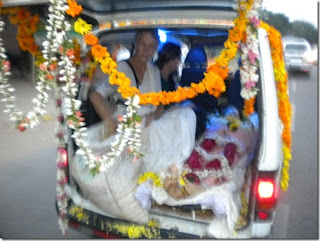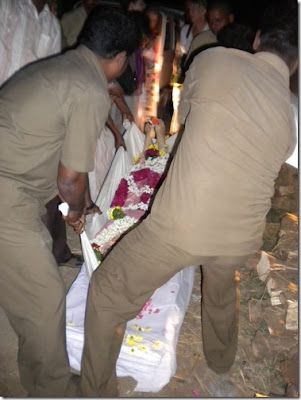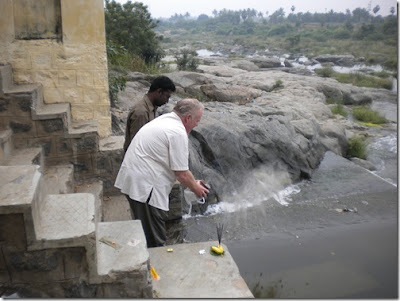1/13/10






A van, adorned with flowers carries Sarasvati and friends to the cremation grounds
It is my pleasure to share with you the experiences of Richard Clarke, a spiritual seeker and expat living in Tiruvannamalai, India. Richard writes beautifully about his experiences observing, and engaging in Indian village life. In November 2008, I shared photos from Richard's blog 'Living in the Embrace of Arunachala' documenting the preparation of a funeral vehicle. Recently, Richard wrote to me that one of his fellow seekers and expats passed away, and he wished to share his experience with the readers of The Daily Undertaker. On his blog, he has documented the experience from death, through preparations for cremation, the procession, the cremation, the gathering of cremated remains, all the rituals involved in each step, and finally the scattering of the remains. I have included photos and excerpts from his posts, and I strongly encourage you to follow the links and read the full story yourselves. There is a beauty of completeness, affirmation of life, acceptance, and generous, meaningful participation in this story, that may change your view about the rituals surrounding death. It has certainly enriched my understanding.
"In India, when this happens, events move fast. There is a most powerful tradition that the body is to be cremated that day. So I, accompanied by Rajan, our driver, the person who gave Sarasvati the most support over the last few months, had to go to the police and to government offices to properly register the death. Meanwhile, Carol, helped by other of Sarasvati’s friends, waited at her apartment to prepare the body."

Rickshaw Drivers, strangers to the deceased, stop their work to help with the cremation rituals.
"I have to again say a few words about the rickshaw drivers. These men are thought to be “low class” by many Indians and Westerners. What we saw this day was how they stepped in and took on the role of family to Sarasvati, a Westerner with no family here. They did this readily and freely, without asking for anything. They were loving and unstinting in their care for Sarasvati on this day. I offer them my deepest thanks. "

Taking on the role of eldest son, Richard lights the pyre

The cremated remains are later gathered from the ashes of the pyre.

Scattering the remains in the river.
"I stop for a bit, to say a last farewell to the body of a friend and fellow spiritual seeker, Sarasvati.I then look once more at the peaceful and beautiful waters here. My thought is that I too may be blessed to die with Arunachala, and maybe this is where the last remains of this body will be placed."Now we can go home, take our morning baths and eat breakfast."
The rituals and practices described and pictured in Richard's account may seem foreign and strange to us, and many of the procedures, such as fueling the fire with tires, kerosene and cow dung, would not necessarily be acceptable in the West. However, what translates beautifully is the power of the participation of friends in the rituals surrounding death and disposition. In Richard's account we experience the fullness and completion of the necessary tasks that bring us from the experience of death, back to life. I would argue strongly that those necessary tasks include ritual just as much as disposition, and participation in each is powerfully healing for those who grieve.
For the full posts and many more photos, please visit:
and


1 comment:
This was a beautifully written article. Thank you for sharing it.
Post a Comment